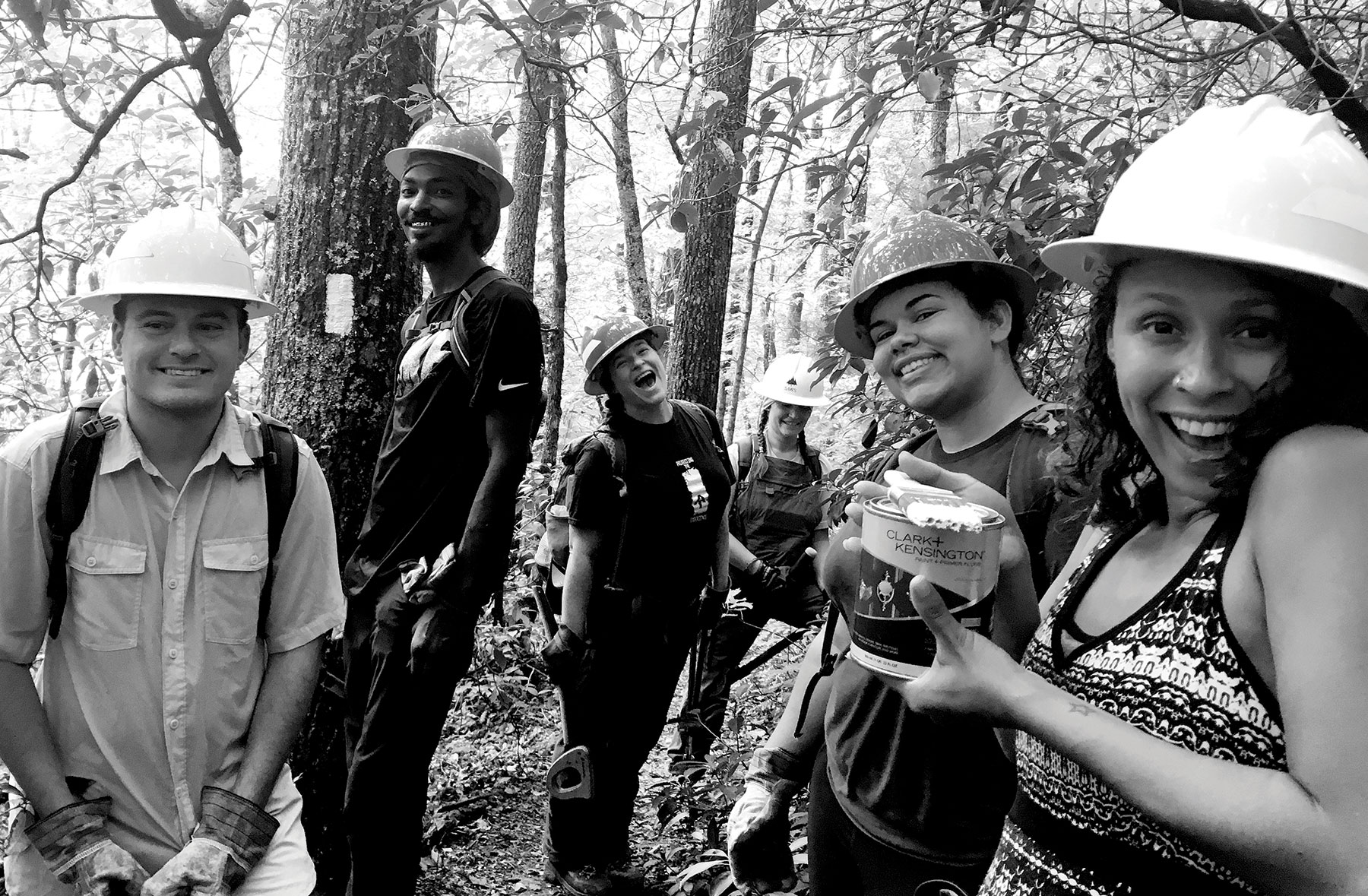


At the ATC, we recognize that our mission to preserve and protect the Trail outlives our own contributions to the effort. That’s why we are developing an Emerging Leader’s Network to invite young adults to the stewardship and recreational experiences the Trail has to offer. For young people, these experiences can increase occupational awareness, self-efficacy, personal relevance, connection to identity, and civic and community responsibility for a lifetime. A critical part of our work is identifying and recruiting the next generation of Trail enthusiasts and conservation leaders. To cultivate greater strength and resilience both within the ATC and among emerging ecological leadership outside of the organization, we believe that the next generation of leaders must be as diverse as the population of the United States itself.
The Trail does not exist in a vacuum. Communities of all sizes and demographic profiles exist along its length. Rural, urban, and suburban communities interact with the Trail every day, many depending on the economic, social, and environmental benefits of coexisting with a large wilderness area. As these communities grow and change, it is of critical importance that they have a voice in the stewardship of the Trail. The ATC is actively seeking to identify and eliminate the barriers that could keep people from enjoying the Trail and taking part in its stewardship.
As part of this effort, the ATC hosts Wild East Summits for formal and informal educators in Trail-adjacent communities. These two- or three-day “train the trainer” workshops raise awareness of the economic impact of the Trail and the critical need for a new generation of leaders and stewards.
Since 2005, the ATC has served as a backbone organization for partner organizations and regional educational coalitions, engaging with close to 500 educators from 200 schools across our 14-state footprint. In 2018, the ATC surveyed more than 300 alumni of its previous educator workshops, finding that a majority (65 percent) of responding teachers working in communities near the Trail used service-learning and/or Appalachian Trail materials in their curriculum.
Wild East Summits stress the value of public lands, from pocket parks to the Trail, as teaching resources within the community. Participants develop Place-Based Service-Learning curriculum units and work with community partners to engage students in authentic community-based learning. Summits connect new partner organizations and participants with meaningful Trail skills through hands-on stewardship activities, build an understanding of public lands and the Trail’s unique Cooperative Management System, and create pathways for future career opportunities.
Summits encourage educators to become facilitators of partnerships and engagement, while building collaboration among staff, community partners, and teachers to support students in place-based learning focused on stewardship. “ATC Education workshops have made me a more dynamic, confident teacher,” says Rebekah Lang of Emmaus, Pennsylvania. “They have empowered me to teach not only about the Trail, but about the related topics of environmental education, conservation, and native species. They have reminded me of how rewarding teaching can be and how beneficial it is for all students to spend time outdoors, hiking, exploring nature, and connecting with themselves, each other and our beautiful world.”


This year, the ATC, along with regional coalitions of youth-serving organizations and land managing partners, co-hosted NextGen Summits for young people and emerging leaders in Maine, Massachusetts, Georgia, and western North Carolina. NextGen Summits strengthen the community connection to the landscape and create conservation networks to expand stewardship opportunities for ecologically-minded youth. These summits build the community’s capacity to refresh the traditional image of an environmental steward, create experience-based opportunities for sharing authentic stories, and connect participants to conservation careers and ecological employment opportunities across the region.
NextGen Summits are planned, led, and evaluated by a coalition of participating agencies, creating strong regional networks with the capacity to provide significant resources to help emerging leaders become conservation stewards and establish themselves in the environmental field. Participants leave with a call to action for shared stewardship, and are advocating for more outdoor time at school, inviting family and friends to participate in volunteer work days, and creatively communicating their experiences through social media, blog posts, and podcasts. “I value the time I get to reflect on myself, and how I fit into the world,” says Georgia summit participant Jolee Northup. “My goal is to inspire the upcoming generation to develop a love for nature now so they can help protect and restore these forests when they are older. I am a proud NextGen forest ambassador.”
Finally, the ATC sponsors the NextGen Advisory Council as a unique ladder for engagement opportunities and professional development experiences. The council brings together 16 diverse, young leaders to advocate for the stewardship of the Trail and help forge new partnerships with youth and multicultural organizations and also help the ATC and affiliated organizations build a comprehensive, inclusive strategy to attract young and diverse audiences to the Trail.
By supporting projects, events, and practices that further the ATC’s organizational principles of equity and inclusion, the council works to connect the ATC community to a broader network of people, ideas, and resources. The NextGen Council has a voice in every aspect of the organization, from communications, to administration, to programming. This group is a model for partner club organizations and public land groups around the country.
The Appalachian Trail is a delicate ribbon running along the eastern seaboard from Georgia to Maine. By working with communities to identify and remove barriers to service, inspiring future environmental leaders to address the challenges of disconnection from natural world, and actively building equity in outdoor educational enrichment opportunities, we make of it a living backbone, the active nerve center of the Wild East.
Healthy watersheds begin with healthy forests — and healthy forests require cooperation and empowerment to maintain. For the five million people in Georgia, Alabama, and Florida who rely on the Apalachicola-Chattahoochee-Flint (ACF) River Basin for drinking water, recreation, energy production and agriculture, healthy watersheds are imperative. That’s why for this year’s Maymester course: Field Program in Environmental Problem Solving, University of Georgia Odum School of Ecology students started their two-week journey in Helen, Georgia, in the heart of the Chattahoochee National Forest.
The course, which centered around water-use conflicts and sustainability issues in the ACF River Basin, brought students into contact with nearly 25 organizations throughout the ACF, including the Appalachian Trail Conservancy, Chattahoochee Riverkeeper, Flint Riverkeeper, Apalachicola National Estuarine Research Reserve, West Atlanta Watershed Alliance, the Army Corps of Engineers, the Southern Environmental Law Center, Joseph Farley Nuclear plant, and numerous environmental leaders affiliated with the ACF Stakeholders group.
It also gave students an opportunity to immerse themselves in the natural systems they were learning about: they spent their day at Dick’s Creek Gap helping to maintain trails, remove invasive species, and break down campsites in undesignated areas, all activities that protect the forest and the many headwater streams within it.
Julie Judkins, the ATC’s director of education and outreach, led the student teams together with Trail Education Specialist, Chloe De Camara. “Volunteerism is a learned behavior and not an inherent act,” said Judkins.
For some students, this exposure inspired new passion. “After talking to the ATC, I realized that my passion lies with conserving the land that has not been developed into more urbanized area,” said Lucas Lambert. “We take our land for granted; we don’t always appreciate the beauty that is right in our backyards. I want to conserve nature while at the same time increasing its beauty, because these parts of the world are valuable.”
These natural resources — from the Chattahoochee National Forest to the portion of the Flint that disappears beneath the Atlanta airport — and the stakeholders who rely on them combine to form a complex social-ecological system. Due to the intense demand for water from multiple sources — including thousands of native species that rely on freely flowing freshwater in the ACF to survive — conflict has escalated to the point of several lawsuits between the three states.

The U.S. Army Corps of Engineers manages flows through dams located across the ACF River Basin. Lake Lanier’s Buford Dam, which was initially constructed to provide flood control and hydropower, now serves primarily as Atlanta’s source of drinking water. However, Alabama and Florida argue that Georgia withdraws too much water from the Chattahoochee and Flint rivers, causing ecological and economic damage to their states.
“As we met with stakeholders along the ACF River Basin, I was truly able to realize just how reliant society is on the environment,” student Maggie Smith reflected. “Every single person along the rivers is deeply dependent on the availability of water and the ecosystem services the rivers provide. Therefore, they have a strong interest in making sure that the water supply is significant enough to support themselves as well as the environment.”
The students also felt that the cooperative network that maintains the Appalachian Trail serves as an example for how the ACF might solve some of their own conflicts: “When asked about the challenges of using a cooperative management system, we were told that it is vital to understand who’s not at the table. This idea should be applied to any problem solving/conflict resolution effort because including people who were otherwise excluded can increase the knowledge of the situation and potential impacts. By doing so, there is a shared understanding of the issue and a solution with minimal negative impact,” wrote students Cydney Abel, Mary Hunt, Sam Lopez in one of their reflections.
Jasmine Forde, lecturer in the Odum School of Ecology designed the course to engage new stakeholders and give students an opportunity to think through a focal sustainability problem, with all of its complexity. Amanda Rugenski, a lecturer who co-taught the course with Forde said: “We wanted our students to think about the concept of resilience through different lenses — social, ecological, and economic.” Mostly, Forde and Rugenski hope that the students now understand how the health of an entire system — from the species that live in the currents of a river to the communities who rely on it for drinking water — starts in the same place where many Appalachian Trail thru-hikers also begin their journey, the Chattahoochee National Forest.